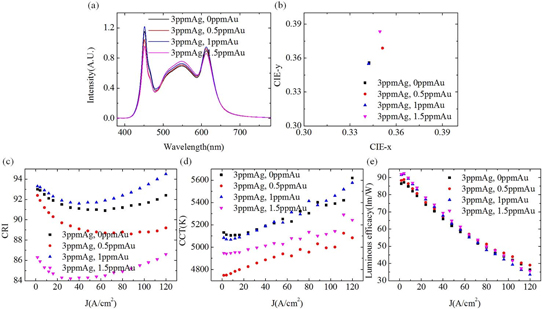- News
19 September 2019
Improving white light-emitting diode luminous efficiency and color rendering
Researchers based in China have combined phosphors, quantum dots and metal nanoparticles to create blue-to-white light converters for indium gallium nitride (InGaN) light-emitting diodes (LEDs) with simultaneously improved luminous efficiency and color rendering [Rongqiao Wan et al, Optics Letters, vol44, p4155, 201]. Often improved color rendering comes at the cost of reduced luminous efficiency.
The approach adopted by Central South University, Semiconductor Lighting Technology Research and Development Center, and University of Chinese Academy of Sciences, enables a broader spectrum of light over the visible range, filling in the red end of the spectrum, compared with the lost-cost white LEDs using yellow phosphors that are presently in mass production.
The researchers combined green-emitting and red-emitting phosphors with silver (Ag) and gold (Au) nanoparticles (NPs). The broadband green emitter consisted of cerium-doped lutetium aluminium garnet (LuAG:Ce, Al5Lu3O12). Core/shell cadmium selenide/zinc sulfide (CdSe/ZnS) quantum dots (QDs) in toluene solvent provided a narrowband blue-to-red converter. The Ag NPs, on average, were 15nm diameter, and the Au NPs 70nm diameter. The NPs were dispersed in toluene.
The materials were mixed into silicone gel, and the mixture was placed in vacuum for 90 minutes to remove the toluene. The gel was then dropped onto 10milx23mil 451nm blue LED chips in a lead frame. The blue electroluminescence of the LEDs had a full-width at half maximum (FWHM) of 17nm. Thermal curing at 130°C lasted 15 minutes. All the samples contained the green phosphor and red QDs, but some also contained silver (Ag-WLEDs) or silver and gold (AgAu-WLEDs) NPs to give white LEDs. The samples without NPs were designated wo-WLEDs.

Figure 1: Schematic mechanisms and energy transfer paths for (a) wo-WLEDs; (b) Ag-WLEDs; and (c) AgAu-WLEDs.
The blue-to-white conversion layer was designed to take advantage of a variety of physical processes (Figure 1). The green (544nm wavelength under photoluminescence, 106nm FWHM) and red (613nm, 30nm FWHM) phosphors/QDs operated through Stokes processes of absorption of blue photons and emission of the longer-wavelength, lower-energy green and red light. Since green light has higher photon energy than red, some green-to-red conversion might also be expected. The use of QDs was also expected to add non-radiative energy transfer (NRET) channels between the green and red emitters.
The metal NPs were also hoped to provide NRET enhancement. The Ag NPs also absorbed the main blue light (454nm absorption peak) from the LED active region through localized surface plasmon resonance (LSPR). The team comments: “Due to the resonant light scattering effect, the absorption cross section of LuAG:Ce and CdSe/ZnS QDs for blue light increases, thus enhancing color conversion efficiency.” Plasmons are oscillations of electron density.
The Au NPs were designed to have localized surface plasmon resonance with the green emissions (531nm peak). The researchers also suggest that the resonance may provide an environment that gives Purcell-effect enhancement of spontaneous emission of the phosphor and QDs.
Table 1: CRI, CCT and LE of Ag-WLEDs with varied NP concentrations.
Ag NPs (ppm) |
Current density (A/cm2) | CRI | CCT (K) | LE (lm/W) |
| 0 | 4 | 89 | 5800 | 81 |
| 0 | 40 | 90.8 | 6000 | 61 |
| 1 | 4 | 90 | 5500 | 82 |
| 1 | 40 | 92 | 5700 | 61 |
| 3 | 4 | 93 | 5100 | 87 |
| 3 | 40 | 91 | 5200 | 66 |
| 5 | 4 | 93.6 | 5230 | 86 |
| 5 | 40 | 92.6 | 5450 | 64 |
The researchers first investigated the improvements achievable with varied concentrations of Ag NPs (Table 1). The peak color rendering index (CRI) of 93.6 was achieved with 5 parts per million (ppm) NPs, by weight, and 4A/cm2 current injection. Higher luminous efficiency (LE) of 87 lumens per watt (lm/W) was found with 3ppm NPs at 4A/cm2. The 3ppm Ag-WLEDs also demonstrated the lowest correlated color temperature (CCT) of 5100K at 4A/cm2. A low CCT indicates higher red and green content in the ‘white’ light, which is associated with ‘warmer’ illumination compared with regular white light.
Table 2: CRI, CCT and LE of AgAu-LED with varied Au NP concentrations and constant 3ppm Ag NPs.
Au NPs (ppm) |
Current density (A/cm2) | CRI | CCT (K) | LE (lm/W) |
| 0 | 4 | 93 | 5100 | 87 |
| 0 | 40 | 91 | 5200 | 66 |
| 0.5 | 4 | 92 | 4750 | 89 |
| 0.5 | 40 | 89 | 4880 | 67 |
| 1 | 4 | 93.2 | 5070 | 92 |
| 1 | 40 | 92 | 5200 | 68 |
| 1.5 | 4 | 86 | 4950 | 92.5 |
| 1.5 | 40 | 84.3 | 5010 | 69.5 |
The Ag-WLEDs were further enhanced with Au NPs (Table 2). The Ag NP concentration was fixed at 3ppm. The incorporation of 1ppm Au NPs enabled an increase in luminous efficiency to 92lm/W at 4A/cm2, while the CRI and CCT were 93.2 and 5070K, respectively. Increasing the injection current to 120A/cm2enhanced the CRI to 94.5 (Figure 2). With 1.5ppm Au NPs the luminous efficiency increased to 92.5lm/W at 4A/cm2, but at the cost of reduced 86 CRI.

Figure 2: (a) Electroluminescence spectra of Ag-WLEDs and AgAu-WLEDs with varied concentration of Au NPs and constant 3ppm Ag concentration under 20mA (16A∕cm2) injection current. (b) CIE-1931 chromaticity coordinates of AgAu-WLED, (c) CRI, (d) CCT and (e) LE of Ag-WLEDs and AgAu-WLEDs versus current density.
The team expects further enhancements from “package and energy transfer structure optimization” to reduce energy losses.
White LEDs InGaN Phosphors Quantum dots Metal nanoparticles
https://doi.org/10.1364/OL.44.004155
The author Mike Cooke is a freelance technology journalist who has worked in the semiconductor and advanced technology sectors since 1997.


